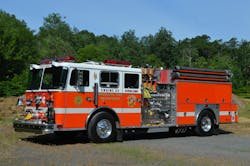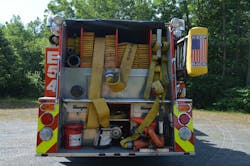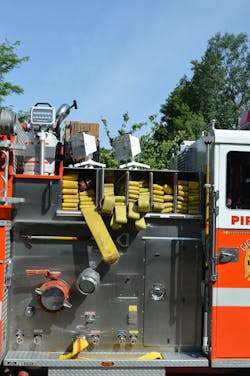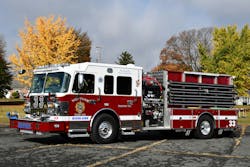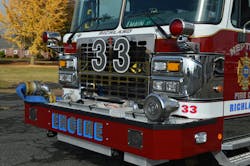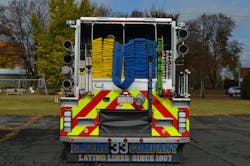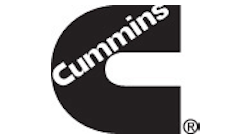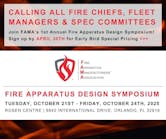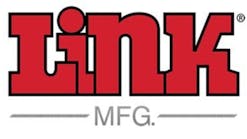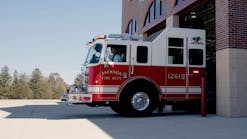The Apparatus Architect: Pumpers Designed to Move Big Water
In the early years of motorized apparatus, it was common for departments to operate as two-piece engine companies that consisted of a hose wagon that carried 2½-inch hose and a pumper that was rated at 500–750 gpm. As larger chassis and higher horsepower engines were developed, the triple combination pumper became the preferred vehicle, because a single rig could carry hose, appliances, a small water tank and a centrifugal fire pump that had a rating of as much as 1,000 gpm.
The National Board of Fire Underwriters (NBFU) emphasized the importance of producing an adequate and reliable water supply when developing the fire insurance rating for communities. The hydrant flow testing that was conducted by the NBFU was critical when assessing the fire protection level and the appropriate number of engine and ladder companies. Historically, large city departments operated with companies that were outfitted with large-diameter hose (LDH) along with multiple master stream appliances to combat major fires.
Dating back to 1903, the Philadelphia Fire Department initiated pipeline engine companies that were outfitted with 3½-inch hose that was utilized in conjunction with the newly completed high-pressure fire system. This concept again was deployed in 1981 when a number of engine companies were designated as pipeline units and assigned a second pumper that was outfitted with 5-inch hose.
The city of Syracuse, NY, is served by a gravity-fed water system that provides strong fire flows. One part of the Syracuse Fire Department’s (SFD) reorganization in 1970 was a change to 3½-inch supply line—and later to 4-inch supply line—from 2½-inch, with each pumper equipped with two 750-foot beds of supply line. The standard procedure was to have each engine company lay two supply lines at a working fire to provide an adequate water supply. For many years, SFD engine companies operated as a two-piece unit, to include a mini pumper and a 2,000-gpm pumper that was equipped with four preconnect attack lines, a 50-foot telescopic water tower and portable master stream appliances.
Thus, the concept of having sufficient supply line in both length and diameter to support efficient water movement at an incident to match the rated pump capacity on engine apparatus isn’t new. Progressive departments are recognizing the importance of water supply to develop effective fire streams on both handlines and master stream appliances.
Maximizing water supply
The Freeland, PA, Fire Department (FFD) is a progressive volunteer organization that protects the borough of Freeland and adjacent municipalities in Carbon County and Luzerne County. It responds to approximately 230 incidents annually. The department staffs two pumpers, a rear-mount ladder truck and a utility. It has a long history of operating with well-designed apparatus, dating back to a 1974 FWD Seagrave pumper, which at one point was rebuilt to provide multiple preconnected handlines, two master stream appliances and LDH.
FFD operations are funded partially by a joint agreement between the borough and the department along with a fire tax and various fund raising efforts, which provide funds for PPE, SCBA, hose and other equipment. Some of these funds were dedicated to acquiring a portable flow meter and pitot and test gauges to research and determine attack line flows and to test new hoseline packages. Target fire flows were determined to be 200 gpm with a 50-psi, 1-inch smooth bore nozzle for the smaller handlines and 325 gpm on 2½-inch handlines with a 1¼-inch tip. Further testing is being conducted to determine the flow capability on 2-inch hose with 2½-inch couplings with the piping layouts on both of the FFD pumpers.
Engine 54 is a 1992 Seagrave 2,000-gpm pumper that has a 750-gallon tank. The apparatus was designed to maximize the available water supply that’s within the portions of the response district where strong fire flows are available. The pumper is outfitted with seven attack lines, including a 150-foot 1¾-inch line on the front bumper, four 1¾-inch crosslay attack lines (two 150-foot and two 200-foot) and two 200-foot 1¾-inch lines that are stored in the rear hosebed. Also carried: a bulk bed of 500 feet of 3-inch hose in the rear and a 150-foot 3-inch setback line that has a gated wye in a crosslay bed.
Supply line consists of two beds of 5-inch hose, with 1,000 feet in each. A rear step-mounted portable deck gun is supplied with a 150-foot 3-inch preconnected line with a top-mounted Stang gun; each is equipped with a 1⅜-inch smooth bore tip.
When it was ordered, the design features of Engine 54 were innovative. This was long before the current renewed interest in determining needed target flow and new attack line hose construction.
Rural water supply
Innovative fire apparatus often are found in smaller departments where company members who have different vocational backgrounds bring a range of perspectives when they serve on apparatus committees. Such is the case with the Neptune Fire Company, which protects Richland borough of Lebanon County, PA. The department was formed in 1907. After a devastating mill fire in 1919, the community rallied to provide funding for the department’s first motorized vehicle, a 1921 Seagrave 750-gpm pumper.
The volunteer fire company responds to several hundred fire and EMS incidents annually. It operates a pumper, a heavy rescue squad and a utility. Although the municipal water supply that’s in the community provides some minimal fire flows, areas that are in adjacent townships rely on rural water supply.
When the department set out to design the replacement for its 1998 pumper, emphasis was placed on providing initial attack capabilities along with adequate supply line and a large water tank. As a result, a new Engine 33 was placed into service in October 2024: a Spartan Gladiator chassis with stainless-steel bodywork by 4 Guys Fire Trucks. The rig was built on a 211-inch wheelbase and is powered by a Cummins X12 engine and an Allison EVS 4000 transmission. The fire pump is rated at 1,750 gpm; a 1,250-gallon water tank was designed to provide for a low rear hosebed.
A steel-reinforced bumper protects a front intake and twin bumper attack lines, each carrying a 150-foot 1¾-inch attack line for rapid deployment. Midship mounted in crosslay beds are 200-foot 1¾-inch lines with 2-inch piping that’s routed to the exterior of the bed under each attack line for ease of extending the hoselines from the pump panel.
The rear hosebed accommodates two 2½-inch preconnected attack lines (one 200 feet and one 300 feet), each with a smooth bore nozzle, along with a 400-foot 2-inch attack line, also with a smooth bore nozzle. Supply line hose consists of spilt beds, each with 950 feet of 5-inch hose, which enables company members to lay either dual lines or a single line when a longer supply line is needed for the fire attack. A bulk bed of 300 feet of 2½-inch line is carried for extended hose lays.
Rural water supply appliances are equipped with Storz fittings to enhance efficiency when the pumper is operating as a fill site unit, with the apparatus capable of drafting from all four sides. Access to the top-mounted manual deck gun is by a stainless-steel ladder that’s on the right side at the pump panel. This eliminates folding steps, which can be problematic when they’re mounted at the front of the apparatus body.
Balancing act
Neptune Fire Company’s Engine 33 enhances the department’s attack and water supply capabilities to meet the needs of the response district. Designing engine company units to serve in both hydranted and rural water supply areas requires maintaining a balance to ensure that vehicles have a manageable size with respect to wheelbase and overall length while providing the necessary hose, tools and equipment to function in these roles.
When apparatus committees develop specifications, they must focus on the primary mission of a vehicle to determine the most appropriate design features that will enhance the safety and operational capabilities of the rig.
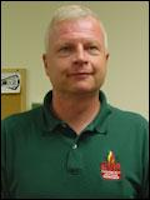
Tom Shand
TOM SHAND, who is a Firehouse contributing editor, is a 36-year veteran of the fire service. He works with Michael Wilbur at Emergency Vehicle Response, consulting on a variety of fire apparatus and fire department master-planning issues. Shand is a member of the Firehouse Hall of Fame.
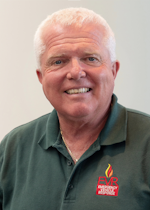
Michael Wilbur
MICHAEL WILBUR, who is a Firehouse contributing editor, retired as a lieutenant in FDNY, where he was last assigned to Ladder Company 27 in the Bronx. He has served on FDNY's Apparatus Purchasing Committee and consults on a variety of apparatus-related issues around the country. Wilbur is a member of the Firehouse Hall of Fame. For further information, access his website at www.emergencyvehicleresponse.com.
